Annual Plasma Neurofilament Dynamics Is a Sensitive Biomarker of Disease Activity in Patients with Multiple Sclerosis
Abstract
1. Introduction
2. Materials and Methods
2.1. Patient Recruitment
2.2. Study Methods
2.2.1. NfL Measurements
2.2.2. MRI Measurements
2.2.3. NEDA Definition
2.3. Data Analysis
2.4. Ethical Considerations
3. Results
4. Discussion
Limitations
5. Conclusions
Author Contributions
Funding
Institutional Review Board Statement
Informed Consent Statement
Data Availability Statement
Acknowledgments
Conflicts of Interest
Abbreviations
| MS | Multiple sclerosis |
| pNfL | Plasma neurofilament light chain |
| NEDA | No evidence of disease activity |
| DMT | Disease modifying therapy |
| MRI | Magnetic resonance imaging |
| PIRA | Progression independent of relapse activity |
| EDSS | Expanded disability status scale |
| BVL | Brain volume loss |
| RMS | Relapsing multiple sclerosis |
| FUV | Follow-up visit |
| SIMOA | Single-molecule array |
| FLAIR | Fluid-attenuated inversion recovery |
| WB | Whole brain |
| GM | Grey matter |
| AR-BVL | Annual rate of brain volume loss |
| Gd | Gadolinium |
| CI | Confidence interval |
| ROC | Receiver operating characteristics |
| AUC | Area under curve |
| IQR | Interquartile range |
| SD | Standard deviation |
References
- Kuhle, J.; Barro, C.; Disanto, G.; Mathias, A.; Soneson, C.; Bonnier, G.; Yaldizli, O.; Regeniter, A.; Derfuss, T.; Canales, M.; et al. Serum neurofilament light chain in early relapsing remitting MS is increased and correlates with CSF levels and with MRI measures of disease severity. Mult. Scler. J. 2016, 22, 1550–1559. [Google Scholar] [CrossRef] [PubMed]
- Håkansson, I.; Tisell, A.; Cassel, P.; Blennow, K.; Zettenberg, H.; Lundberg, P.; Dahle, C.; Vrethem, M.; Ernerudh, J. Neurofilament levels, disease activity and brain volume during follow-up in multiple sclerosis. J. Neuroinflamm. 2018, 15, 209. [Google Scholar] [CrossRef]
- Kuhle, J.; Kropshofer, H.; Haering, D.A.; Kundu, U.; Meinert, R.; Barro, C.; Dahlke, F.; Tomic, D.; Leppert, D.; Kappos, L. Blood neurofilament light chain as a biomarker of MS disease activity and treatment response. Neurology 2019, 92, e1007–e1015. [Google Scholar] [CrossRef]
- Siller, N.; Kuhle, J.; Muthuraman, M.; Barro, C.; Uphaus, T.; Groppa, S.; Kappos, L.; Zipp, F.; Bittner, S. Serum neurofilament light chain is a biomarker of acute and chronic neuronal damage in early multiple sclerosis. Mult. Scler. J. 2019, 25, 678–686. [Google Scholar] [CrossRef]
- Novakova, L.; Zetterberg, H.; Sundström, P.; Axelsson, M.; Khademi, M.; Gunnarsson, M.; Malmestrom, C.; Svenningsson, A.; Olsson, T.; Piehl, F.; et al. Monitoring disease activity in multiple sclerosis using serum neurofilament light protein. Neurology 2017, 89, 2230–2237. [Google Scholar] [CrossRef] [PubMed]
- Disanto, G.; Barro, C.; Benkert, P.; Naegelin, Y.; Schadelin, S.; Giardello, A.; Zecca, C.; Blennow, K.; Zettenberg, H.; Leppert, P.; et al. Swiss Multiple Sclerosis Study Group. Serum neurofilament light chain: A biomarker of neuronal damage in multiple sclerosis. Ann. Neurol. 2017, 81, 857–870. [Google Scholar] [CrossRef] [PubMed]
- Uher, T.; McComb, M.; Galkin, S.; Srpova, B.; Oechtering, J.; Barro, C.; Tyblova, M.; Bergsland, N.; Krasensky, J.; Dwyer, M.; et al. Neurofilament levels are associated with blood barrier integrity, lymphocyte extravasation, and risk factors following the first demyelinating event in multiple sclerosis. Mult. Scler. J. 2020, 27, 220–231. [Google Scholar] [CrossRef] [PubMed]
- Uher, T.; Havrdova, E.; Sobisek, L.; Krasensky, J.; Vaneckova, M.; Seidl, Z.; Tyblova, M.; Ramasamy, D.; Zivadinov, R.; Horakova, D. Is no evidence of disease activity an achievable goal in MS patients on intramuscular interferon-beta-1a treatment over long-term follow-up? Mult. Scler. J. 2017, 23, 242–252. [Google Scholar] [CrossRef] [PubMed]
- Sormani, M.P.; Kappos, L.; Häring, D.A.; Kropshofer, H.; Barro, C.; Leppert, D.; Tomic, D.; Kuhle, J. Including blood neurofilament light chain in the NEDA concept in relapsing-remitting multiple sclerosis trials, S24.007. Neurology 2018, 90, 79895041. Available online: https://www.semanticscholar.org/paper/Including-Blood-Neurofilament-Light-Chain-in-the-in-Sormani-Kappos/5062a66a02e0a1ed358818f28d0c99c97d489667 (accessed on 10 April 2018).
- Weinstock-Guttman, B.; Medin, J.; Khan, N.; Korn, J.R.; Lahti, E.; Silversteen, J.; Calkwood, J.; Silva, D.; Zivadinov, R.; MS-MRIUS Study Group. Assessing “No Evidence of Disease activity” status in patients with relapsing-remitting multiple sclerosis receiving fingolimod in routine clinical practice: A retrospective analysis of the multiple sclerosis clinical and magnetic resonance imaging outcomes in the USA (MSMRIUS) study. CNS Drugs 2018, 32, 75–84. [Google Scholar]
- Giovannoni, G.; Tomic, D.; Bright, J.R.; Havrdova, E. No evident disease activity: The use of combined assessments in the management of patients with multiple sclerosis. Mult. Scler. J. 2017, 23, 1179–1187. [Google Scholar] [CrossRef] [PubMed]
- Lublin, F.D.; Häring, D.A.; Ganjgahi, H.; Ocampo, A.; Hatami, F.; Cuklina, J.; Aarden, P.; Dahlke, F.; Arnold, D.L.; Wiendl, H.; et al. How patients with multiple sclerosis acquire disability. Brain 2022, 145, 3147–3161. [Google Scholar] [CrossRef] [PubMed]
- Akgün, K.; Kretschmann, N.; Haase, R.; Proschmann, U.; Kitzler, H.H.; Reichmann, H.; Ziemssen, T. Profiling individual clinical responses by high-frequency serum neurofilament assessment in MS. Neurol. Neuroimmunol. Neuroinflamm. 2019, 6, e555. [Google Scholar] [CrossRef] [PubMed]
- Gunnarsson, M.; Malmeström, C.; Axelsson, M.; Sundstrom, P.; Dahle, C.; Vrethem, M.; Olsson, T.; Piehl, F.; Norgren, N.; Rosengren, L.; et al. Axonal damage in relapsing multiple sclerosis is markedly reduced by natalizumab. J. Ann. Neurol. 2011, 69, 83–89. [Google Scholar] [CrossRef]
- de Flon, P.; Laurell, K.; Sundström, P.; Blennow, K.; Soderstrom, L.; Zettenberg, H.; Gunnarson, M.; Svenningsson, A. Comparison of plasma and cerebrospinal fluid neurofilament light in a multiple sclerosis trial. Acta Neurol. Scand. 2019, 139, 462–468. [Google Scholar] [CrossRef]
- Cross, A. Ocrelizumab treatment reduced levels of neurofilament light chain and numbers of B cells in the cerebrospinal fluid of patients with relapsing multiple sclerosis in the OBOE study S56.008. Neurology 2019, 92, 52. [Google Scholar]
- Hauser, S.L.; Bar-Or, A.; Cohen, J.A.; Comi, G.; Correale, J.; Coyle, P.K.; Cross, A.H.; de Seze, J.; Leppert, D.; Montalban, X.; et al. Ofatumumab versus Teriflunomide in Multiple Sclerosis. N. Engl. J. Med. 2020, 383, 546–557. [Google Scholar] [CrossRef]
- Szilasiová, J.; Rosenberger, J.; Fedičová, M.; Mikula, P.; Urban, P.; Gdovinova, Z.; Vitková, M.; Hanes, J.; Stevens, E. Neurofilament light chain levels are associated with disease activity determined by no evident disease activity in multiple sclerosis patients. Eur. Neurol. 2021, 84, 227–279. [Google Scholar] [CrossRef]
- Szilasiová, J.; Mikula, P.; Rosenberger, J.; Fedičová, M.; Gdovinova, Z.; Urban, P.; Frigová, L. Plasma neurofilament light chain levels are predictors of disease activity in multiple sclerosis as measured by four-domain NEDA status, including brain volume loss. Mult. Scler. J. 2021, 27, 2023–2030. [Google Scholar] [CrossRef]
- Kurtzke, R.F. Rating neurologic impairment in multiple sclerosis: An expanded disability status scale (EDSS). Neurology 1983, 33, 1444–1452. [Google Scholar] [CrossRef]
- Kuhle, J.; Barro, C.; Andreasson, U.; Derfuss, T.; Lindberg, R.; Sandelius, A.; Liman, V.; Norgren, N.; Blennow, K.; Zettenberg, H. Comparison of three analytical platforms for quantification of the neurofilament light chain in blood samples: ELISA, electrochemiluminescence immunoassay and Simoa. Clin. Chem. Lab. Med. 2016, 54, 1655–1661. [Google Scholar] [CrossRef] [PubMed]
- Steenwijk, M.D.; Amiri, H.; Schoonheim, M.M.; de Sitter, A.; Barkhof, F.; Pouwela, P.J.W.; Vrenken, H. Agreement of MSmetrix with established methods for measuring cross-sectional and longitudinal brain atrophy. Neuroimage Clin. 2017, 15, 843–853. [Google Scholar] [CrossRef] [PubMed]
- De Stefano, N.; Stromillo, M.L.; Giorgio, A.; Bartolozzi, M.L.; Battaglini, M.; Baldini, M.; Portaccio, E.; Amato, M.P.; Sormani, M.P. Establishing pathological cut-offs of brain atrophy rates in multiple sclerosis. J. Neurol. Neurosurg. Psychiatry 2016, 87, 93–99. [Google Scholar] [CrossRef]
- European Medicines Agency Committee for Medicinal Products for Human Use. Guideline on Clinical Investigation of Medical Products for the Treatment of Multiple Sclerosis EMA/CHPM/771815/2011, Rev.2. Available online: https://www.ema.europa.eu/en/documents/scientific-guideline/guideline-clinical-investigation-medicinal-products-treatment-multiple-sclerosis_en-0.pdf (accessed on 26 March 2015).
- Prosperini, L.; Fanelli, F.; Pozzilli, C. Long-term assessment of no evidence of disease activity with natalizumab in relapsing-remitting multiple sclerosis. J. Neurol. Sci. 2016, 364, 145–147. [Google Scholar] [CrossRef]
- Prosperini, L.; Ruggieri, S.; Haggiag, S.; Tortorella, C.; Pozzilli, C.; Gasperini, C. Prognostic Accuracy of NEDA-3 in Long-term Outcomes of Multiple Sclerosis. Neurol. Neuroimmunol. Neuroinflamm. 2021, 8, e1059. [Google Scholar] [CrossRef]
- Barro, C.; Benkert, P.; Disanto, G.; Tsagkas, C.; Amann, M.; Naegelin, Y.; Leppert, D.; Gobbi, C.; Granziera, C.; Yaldizli, Ö.; et al. Serum neurofilament as a predictor of disease worsening and brain and spinal cord atrophy in multiple sclerosis. Brain 2018, 141, 2382–2391. [Google Scholar] [CrossRef]
- Bittner, S.; Steffen, F.; Uphaus, T.; Muthuraman, M.; Fleischer, V.; Salmen, A.; Luessi, F.; Berthele, A.; Klotz, L.; Meuth, S.G.; et al. Clinical implications of serum neurofilament in newly diagnosed MS patients: A longitudinal multicentre cohort study. EbioMedicine 2020, 56, 102807. [Google Scholar] [CrossRef]
- Srpova, B.; Uher, T.; Hrnciarova, T.; Barro, C.; Andelova, M.; Michalak, Z.; Vaneckova, M.; Krasensky, J.; Noskova, L.; Kubala Havrdova, E.; et al. Serum neurofilament light chain reflects inflammation-driven neurodegeneration and predicts delayed brain volume loss in early stage of multiple sclerosis. Mult. Scler. J. 2020, 27, 52–60. [Google Scholar] [CrossRef]
- Uher, T.; Schaedelin, S.; Srpova, B.; Barro, C.; Bergsland, N.; Dwyer, M.; Tyblova, M.; Vodehnalova, K.; Benkert, P.; Oechtering, J.; et al. Monitoring of radiologic disease activity by serum neurofilaments in MS. Neurol. Neuroimmunol. Neuroinflamm. 2020, 7, 714. [Google Scholar] [CrossRef]
- Manouchehrinia, A.; Piehl, F.; Hillert, J.; Kuhle, J.; Alfredson, L.; Olsson, T.; Kockum, I. Confounding effect of blood volume and body mass index on blood neurofilament light chain levels. Ann. Clin. Transl. Neurol. 2020, 7, 139–143. [Google Scholar] [CrossRef] [PubMed]
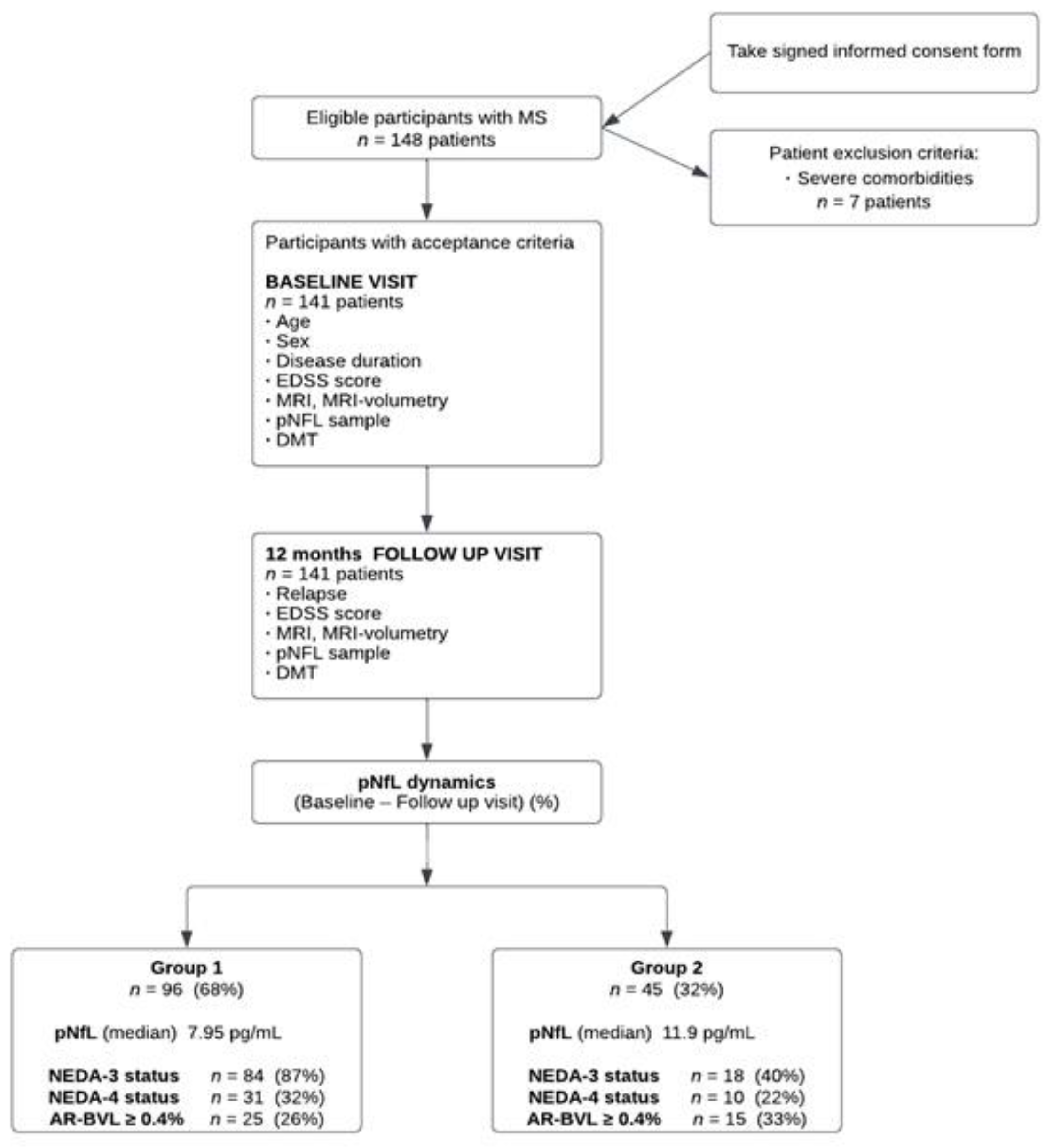
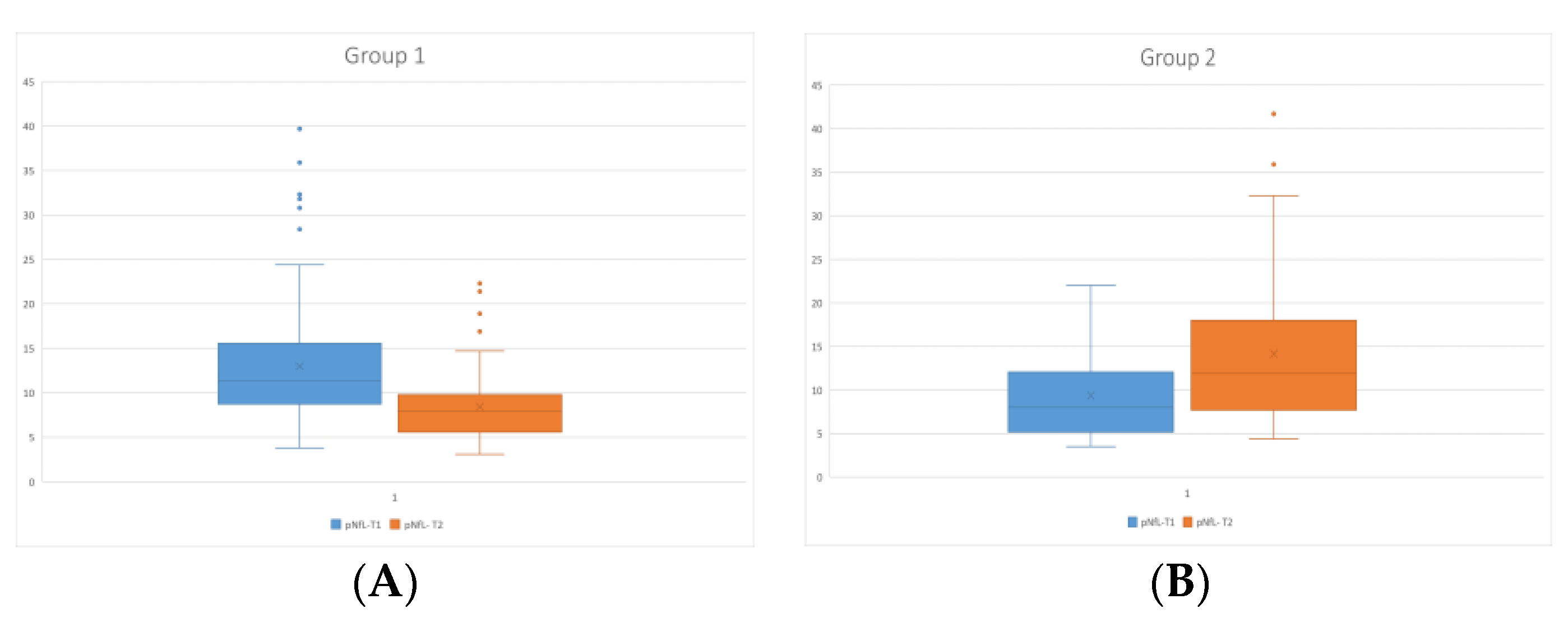
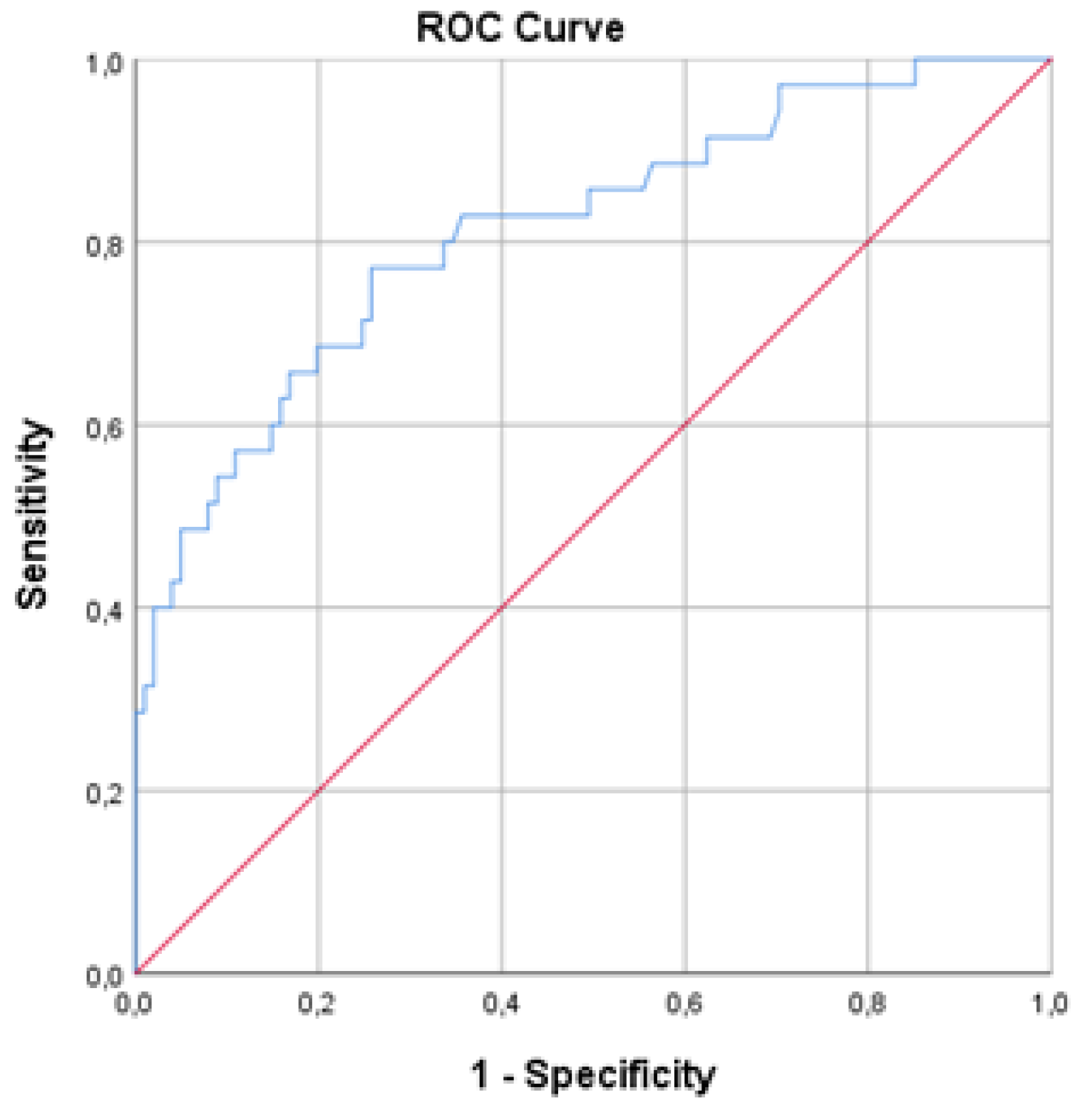
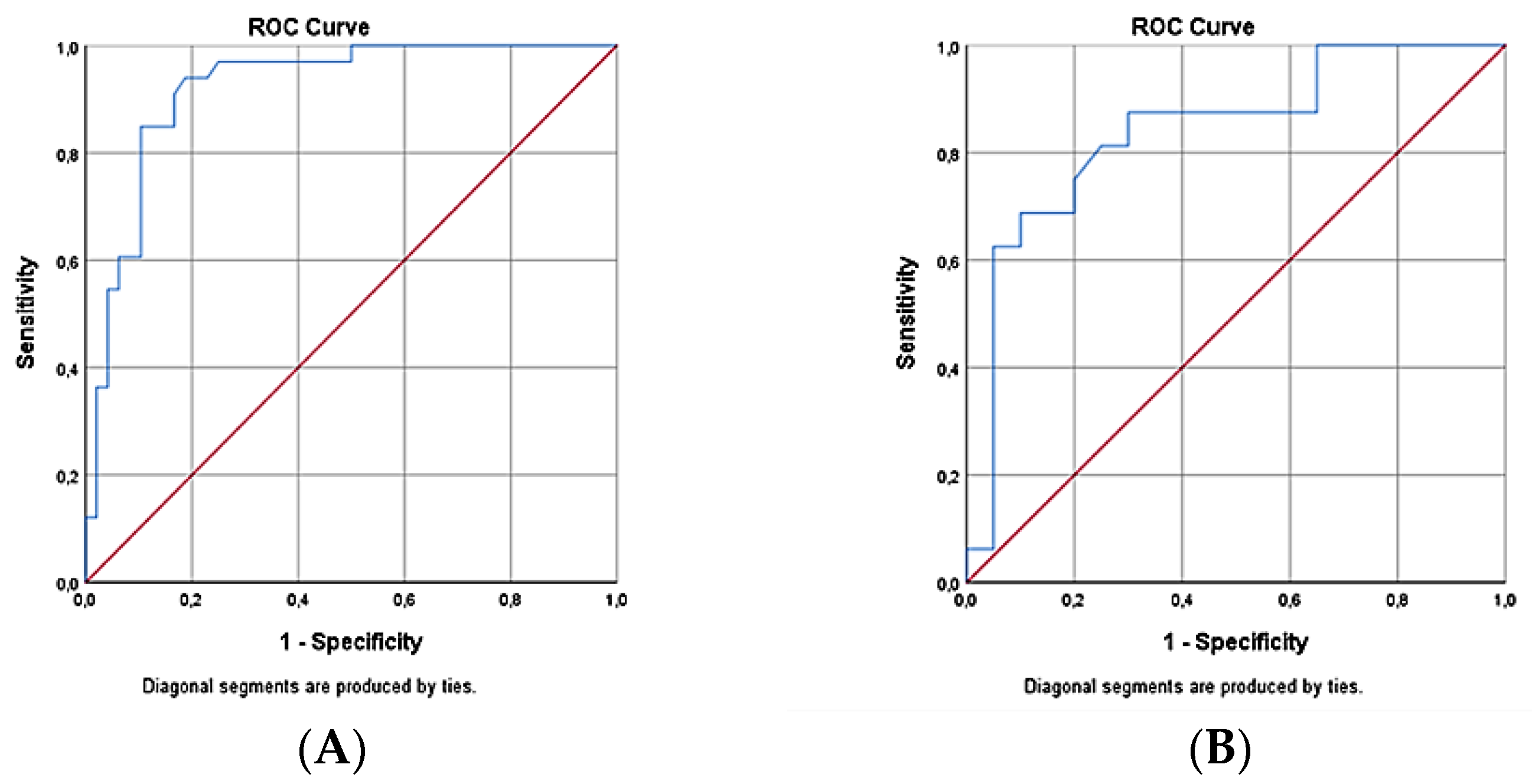
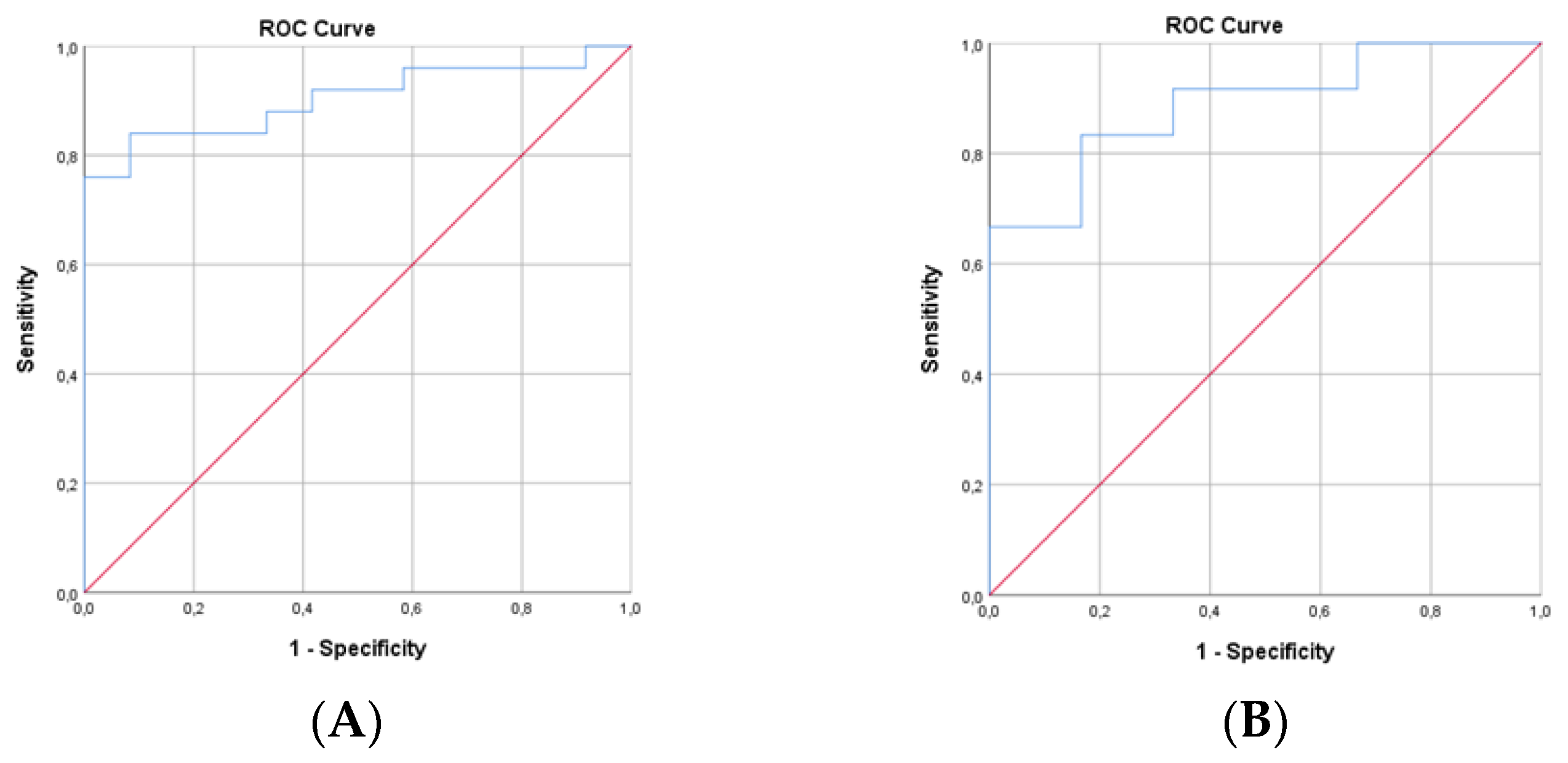
| Variable | Total | Group 1 | Group 2 | Difference between Groups 1 and 2 (p Value) |
|---|---|---|---|---|
| NfL dynamics | Decrease or increase ˂10% | Increase ≥10% | Sig. | |
| ||||
| Sample size, n (%) | 141 (100) | 96 (68) | 45 (32) | |
| Age (years) at baseline visit, mean (SD) | 42.33 (10.2) | 42.78 (9.9) | 41.36 (10.8) | |
| ||||
| Disease duration (years) at baseline visit, median, IQR | 12 (8.5–18) | 12 (7.3–18) | 12 (9–18.5) | |
| EDSS score at FUV, median, IQR | 4.0 (3.5–5) | 4 (3–5) | 4.3 (3.5–5) | |
| pNfL at FUV, pg/mL, median, IQR | 8.9 (6.3–11.9) | 7.95 (5.6–9.8) | 11.9 (7.7–18) | p < 0.001 |
| pNfL dynamics at FUV, %, median, IQR | −10.3 (−37.4–25) | −25 (−46.0–−9.1) | 44.4 (26.6–83.4) | p < 0.001 |
| Patients with relapse last 12 months at FUV, n (%) | 26 (18.4) | 8 (8.3) | 18 (40) | p < 0.001 |
| Patients with EDSS worsening at FUV, n (%) | 25 (17.7) | 6 (6.3) | 19 (42.2) | p < 0.001 |
| Time from the last relapse to FUV, months, median, IQR | 12 (7–21) | 13 (8–20) | 9 (4–24.8) | |
| ||||
| FLAIR-lesions volume (mL) at FUV, median, IQR | 8.7 (3.8–16.7) | 7.76 (3.1–15.6) | 10.6 (5.9–20.3) | |
| FLAIR-lesions volume change (mL) at FUV, median, IQR | 0.14 (−0.1– 0.5) | 0.13 (−0.1– 0.42) | 0.23 (0.01–0.9) | |
| T1-lesions volume (mL) at FUV, median, IQR | 6.19 (2.3– 13.4) | 5.1 (1.8–12.2) | 7.04 (3.9–14.3) | |
| T1-lesions volume change (mL) at FUV, median, IQR | 0.13 (−0.1– 0.8) | 0.15 (−0.05–0.7) | 0.1 (−0.03–1.1) | |
| WB volume (mL) at FUV, median, IQR | 1494 (1439–1543) | 1495 (1440–1545) | 1494 (1399–1529) | |
| WB annual volume change (%) at FUV, median, IQR | −0.25 (−0.47–0.02) | −0.12 (−0.29–0.1) | −0.29 (−0.57– −0.02) | p < 0.001 |
| WB volume normative percentile at FUV, median, IQR | 5.9 (0.95–23) | 6.6 (0.96–23.95) | 5.05 (0.8–23.1) | |
| GM volume (mL) at FUV, median, IQR | 902 (848–931) | 902.5 (855–938) | 902 (826–923) | |
| GM annual volume change (%) at FUV, median, IQR | −0.4 (−0.79–0.2) | −0.19 (−0.51–0.17) | −0.4 (−1.1–0) | p < 0.001 |
| GM volume normative percentile at FUV, median, IQR | 23.9 (6.1– 42.5) | 23.5 (4.6–45.5) | 24.7 (6.4–41.5) | |
| Patients with MRI activity last 12 months at FUV, n (%) | 18 (12.8) | 6 (6.5) | 12 (26.7) | p < 0.01 |
| Patients with AR-BVL ≥0.4% at FUV, n (%) | 40 (28.4) | 25 (26) | 15 (33.3) | |
| Patients with WB atrophy at FUV, n (%) | 26 (18.4) | 52 (54) | 18 (40) | |
| Patients with GM atrophy at FUV, n (%) | 12 (8.5) | 16 (16.7) | 10 (22) | |
| ||||
| Patients with NEDA-3 status at FUV, n (%) | 102 (70.2) | 71 (74) | 18 (40) | p < 0.001 |
| Patients with NEDA-4 status at FUV, n (%) | 41 (29.1) | 31 (32) | 10 (22.2) | p < 0.05 |
| ||||
| Patients with first-line DMT, n (%) | 34 (24) | 24 (25) | 10 (22.2) | |
| Patients on second-line DMT, n (%) | 107 (76) | 72 (75) | 35 (77.8) |
Disclaimer/Publisher’s Note: The statements, opinions and data contained in all publications are solely those of the individual author(s) and contributor(s) and not of MDPI and/or the editor(s). MDPI and/or the editor(s) disclaim responsibility for any injury to people or property resulting from any ideas, methods, instructions or products referred to in the content. |
© 2023 by the authors. Licensee MDPI, Basel, Switzerland. This article is an open access article distributed under the terms and conditions of the Creative Commons Attribution (CC BY) license (https://creativecommons.org/licenses/by/4.0/).
Share and Cite
Fedičová, M.; Mikula, P.; Gdovinová, Z.; Vitková, M.; Žilka, N.; Hanes, J.; Frigová, L.; Szilasiová, J. Annual Plasma Neurofilament Dynamics Is a Sensitive Biomarker of Disease Activity in Patients with Multiple Sclerosis. Medicina 2023, 59, 865. https://doi.org/10.3390/medicina59050865
Fedičová M, Mikula P, Gdovinová Z, Vitková M, Žilka N, Hanes J, Frigová L, Szilasiová J. Annual Plasma Neurofilament Dynamics Is a Sensitive Biomarker of Disease Activity in Patients with Multiple Sclerosis. Medicina. 2023; 59(5):865. https://doi.org/10.3390/medicina59050865
Chicago/Turabian StyleFedičová, Miriam, Pavol Mikula, Zuzana Gdovinová, Marianna Vitková, Norbert Žilka, Jozef Hanes, Lýdia Frigová, and Jarmila Szilasiová. 2023. "Annual Plasma Neurofilament Dynamics Is a Sensitive Biomarker of Disease Activity in Patients with Multiple Sclerosis" Medicina 59, no. 5: 865. https://doi.org/10.3390/medicina59050865
APA StyleFedičová, M., Mikula, P., Gdovinová, Z., Vitková, M., Žilka, N., Hanes, J., Frigová, L., & Szilasiová, J. (2023). Annual Plasma Neurofilament Dynamics Is a Sensitive Biomarker of Disease Activity in Patients with Multiple Sclerosis. Medicina, 59(5), 865. https://doi.org/10.3390/medicina59050865





